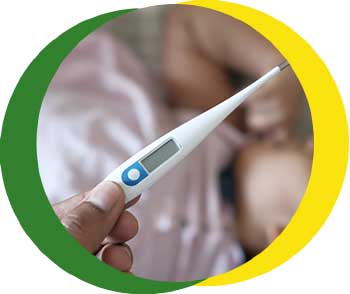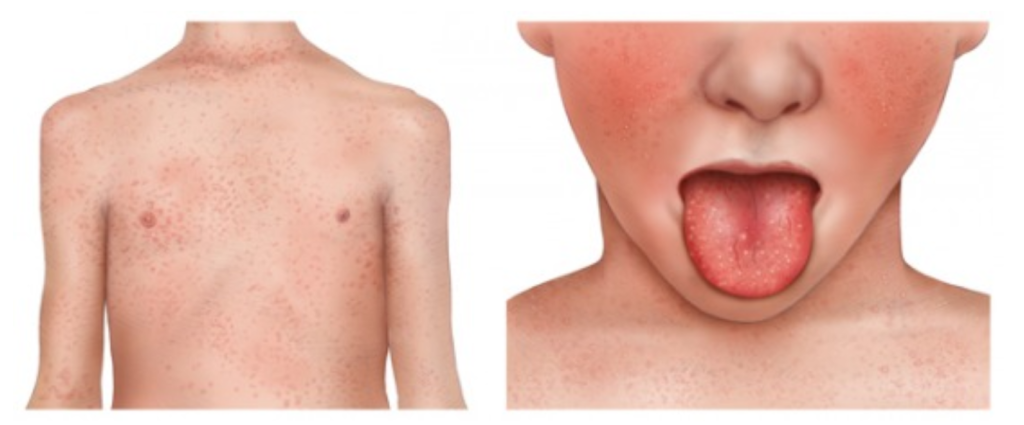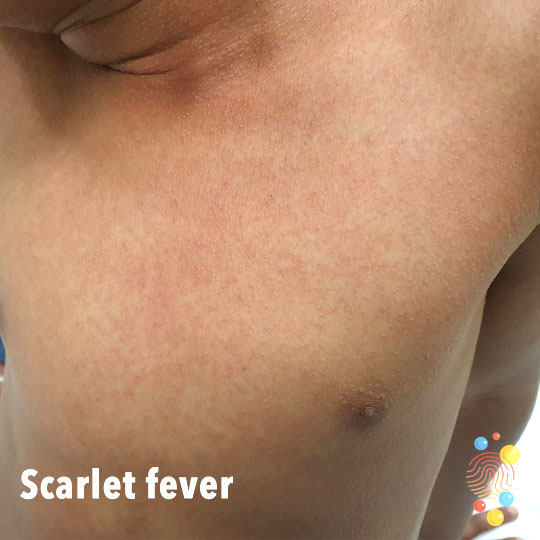Strep A and scarlet fever

Scarlet fever, which is caused by the bacteria Group A streptococcus, is usually a mild illness but it is highly infectious. It much more common in children than in adults; it is important that children with scarlet fever are seen by their GP so that they can be started on antibiotics. This is not only to reduce the chance of their infection becoming more severe but also to stop them from spreading the infection to others, especially people at higher risk of severe infections such as the elderly and those with weakened immune systems.
The rash of scarlet fever often begins with small spots on the body that then spread to the neck, arms and legs over the next 1-2 days. It is often ‘sand-paper’ like to touch but is not itchy.
Your child may also have a:
- Sore throat/tonsillitis
- Fever (temperature of 38°C (100.4°F) or above)
- Painful, swollen glands in the neck
- A red tongue (strawberry tongue).

If your child has a runny nose, cough or diarrhoea, they are extremely unlikely to have scarlet fever.
Occasionally, the bacteria causing scarlet fever can spread to other areas of the body, causing infections in the neck (tonsillar abscesses or lymph node), chest infections (pneumonia) or sepsis.
In addition, a small number of children experience complications in the week or two after recovering from scarlet fever. This can affect their kidneys or their joints.

When should you worry?
If your child has any of the following:
- Becomes pale, mottled and feels abnormally cold to touch
- Is going blue around the lips
- Too breathless to talk/eat or drink
- Has a fit/seizure
- Becomes extremely agitated (crying inconsolably despite distraction), confused or very lethargic (difficult to wake)
- Develops a rash that does not disappear with pressure (the ‘Glass Test‘)
- Is under 3 months of age with a temperature of 38°C / 100.4°F or above (unless fever in the 48 hours following vaccinations and no other red or amber features)
You need urgent help.
Go to the nearest Hospital Emergency (A&E) Department or phone 999
If your child has any of the following:
- Is finding it hard to breathe
- Is becoming drowsy (excessively sleepy) or irritable (unable to settle them with toys, TV, food or picking up) – especially if they remain drowsy or irritable despite their fever coming down
- Seems dehydrated (sunken eyes, drowsy or not had a wee or wet nappy for 12 hours)
- Has extreme shivering or complains of muscle pain
- Develops a painful, red swollen gland in their neck which is increasing in size
- Is 3-6 months of age with a temperature of 39°C / 102.2°F or above (but fever is common in babies up to 2 days after they receive vaccinations)
- Continues to have a fever of 38.0°C / 100.4°F or more for more than 5 days
- Unable to swallow saliva
- If your child has recently had scarlet fever but now appears to have a puffy face/eyelids, tea ‘coca-cola’ coloured urine (pee), or a swollen, painful joint(s)
- Is getting worse or if you are worried
You need to contact a doctor or nurse today.
Please ring your GP surgery or call NHS 111 – dial 111
We recognise that because of COVID-19, at peak times, access to a health care professional may be delayed. If symptoms persist for 4 hours or more and you have not been able to speak to either a member of staff from your GP practice or to NHS 111 staff, then consider taking them to your nearest Emergency Department
If none of the above features are present
Additional advice is also available to young families for coping with crying of well babies.
Self care
Continue providing your child’s care at home. If you are still concerned about your child, call NHS 111 – dial 111
What should you do?
- If you think your child has scarlet fever, they should be seen by their GP. They may need treatment with antibiotics.
- To make your child more comfortable, you may want to lower their temperature using paracetamol (calpol) and/or ibuprofen as per the instructions on the packaging. Use one and if your child has not improved 2/3 hours later you may want to try giving the other medicine. However, remember that fever is a normal response that may help the body to fight infection and paracetamol/ibuprofen will not get rid of it entirely.
- Avoid tepid sponging your child – it doesn’t actually reduce your child’s temperature and may cause your child to shiver.
- Encourage them to drink plenty of fluids.
- Good hand and respiratory hygiene are important for stopping the spread of many bugs. By teaching your child how to wash their hands properly with soap for 20 seconds, using a tissue to catch coughs and sneezes, and keeping away from others when feeling unwell, they will be able to reduce the risk of picking up or spreading infections. So remember to:
- Catch it: always cough or sneeze into a tissue
- Bin it: always throw the used tissue in a bin
- Kill it: always wash your hands with soap and hot water
How long will your child’s symptoms last?
- The sore throat and fever often last for about 3-6 days and the rash usually improves within a week. Antibiotics reduce the length of fever/sore throat by about 1 day.
- Children commonly experience peeling of their fingers and toes after scarlet fever.
- Your child is no longer infectious to others (contagious) after 24 hours of starting antibiotics and can go back to school/nursery if they feel well enough.
Where should you seek help?
- If it is non-urgent speak to your local pharmacist or health visitor
- If your child has any of the above features, urgently see your GP. For an urgent out-of-hours GP appointment, call NHS 111
- You should only call 999 or go to your nearest A&E department in critical or life threatening situations

